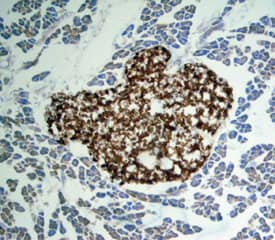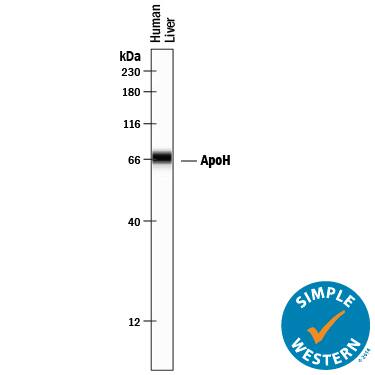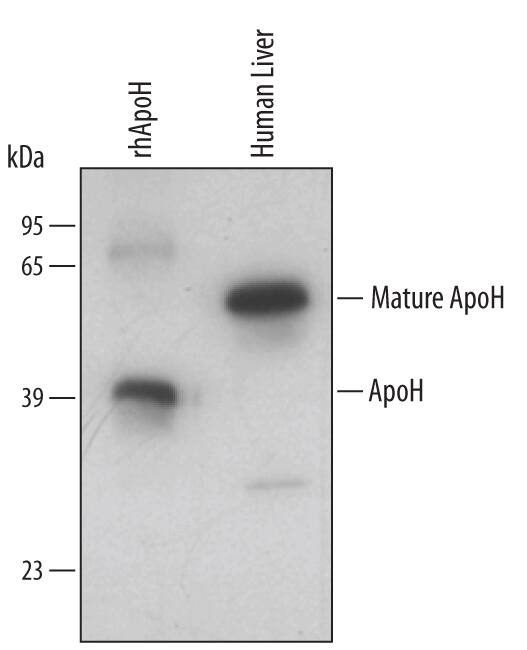Human Apolipoprotein H/ApoH Antibody
R&D Systems, part of Bio-Techne | Catalog # AF5087

Key Product Details
Species Reactivity
Applications
Label
Antibody Source
Product Specifications
Immunogen
Gly20-Cys345
Accession # P02749
Specificity
Clonality
Host
Isotype
Scientific Data Images for Human Apolipoprotein H/ApoH Antibody
Detection of Human Apolipoprotein H/ApoH by Western Blot.
Western blot shows lysates of human liver tissue. PVDF membrane was probed with 1 µg/mL Goat Anti-Human Apolipoprotein H/ApoH Antigen Affinity-purified Polyclonal Antibody (Catalog # AF5087) followed by HRP-conjugated Anti-Goat IgG Secondary Antibody (Catalog # HAF017). For additional reference, recombinant human ApoH (5 ng) was included. A specific band for Apolipoprotein H/ ApoH was detected at approximately 50-60 kDa (as indicated). This experiment was conducted under reducing conditions and using Immunoblot Buffer Group 2.Apolipoprotein H/ApoH in Mouse Pancreas.
Apolipoprotein H/ApoH was detected in perfusion fixed frozen sections of adult mouse pancreas using Goat Anti-Human Apolipoprotein H/ApoH Antigen Affinity-purified Polyclonal Antibody (Catalog # AF5087) at 15 µg/mL overnight at 4 °C. Tissue was stained using the Anti-Goat HRP-DAB Cell & Tissue Staining Kit (brown; Catalog # CTS008) and counterstained with hematoxylin (blue). Specific staining was localized to pancreatic islets. View our protocol for Chromogenic IHC Staining of Frozen Tissue Sections.Detection of Human Apolipoprotein H/ApoH by Simple WesternTM.
Simple Western lane view shows lysates of human liver tissue, loaded at 0.2 mg/mL. A specific band was detected for Apolipoprotein H/ApoH at approximately 69 kDa (as indicated) using 10 µg/mL of Goat Anti-Human Apolipoprotein H/ApoH Antigen Affinity-purified Polyclonal Antibody (Catalog # AF5087) followed by 1:50 dilution of HRP-conjugated Anti-Goat IgG Secondary Antibody (Catalog # HAF109). This experiment was conducted under reducing conditions and using the 12-230 kDa separation system.Applications for Human Apolipoprotein H/ApoH Antibody
Immunohistochemistry
Sample: Perfusion fixed frozen sections of adult mouse pancreas
Simple Western
Sample: Human liver tissue
Western Blot
Sample: Human liver tissue
Formulation, Preparation, and Storage
Purification
Reconstitution
Formulation
Shipping
Stability & Storage
- 12 months from date of receipt, -20 to -70 °C as supplied.
- 1 month, 2 to 8 °C under sterile conditions after reconstitution.
- 6 months, -20 to -70 °C under sterile conditions after reconstitution.
Background: Apolipoprotein H/ApoH
ApoH (Apolipoprotein H; also beta2-Glycoprotein 1/ beta2-GPI) is a 50 kDa, secreted, variably glycosylated, monomeric member of the complement control superfamily of molecules. It is produced by hepatocytes and is bound to HDL particles. Circulating ApoH blocks the intrinsic clotting pathway, and binds to exposed phospholipids on apoptotic cells. Mature human ApoH is 326 amino acids (aa) in length (aa 20‑345). It contains four Sushi repeats (aa 21‑260) and one C-terminal kringle domain (aa 261‑345) that binds heparin and phospholipids. At least two ApoH isoforms exist, one showing a 31 aa substitution for aa 140‑345, while a second represents a bioactive plasmin cleavage product that removes the C-terminal nine amino acids. Mature human ApoH shares 76% aa identity with mouse ApoH.
Alternate Names
Gene Symbol
UniProt
Additional Apolipoprotein H/ApoH Products
Product Documents for Human Apolipoprotein H/ApoH Antibody
Product Specific Notices for Human Apolipoprotein H/ApoH Antibody
For research use only


